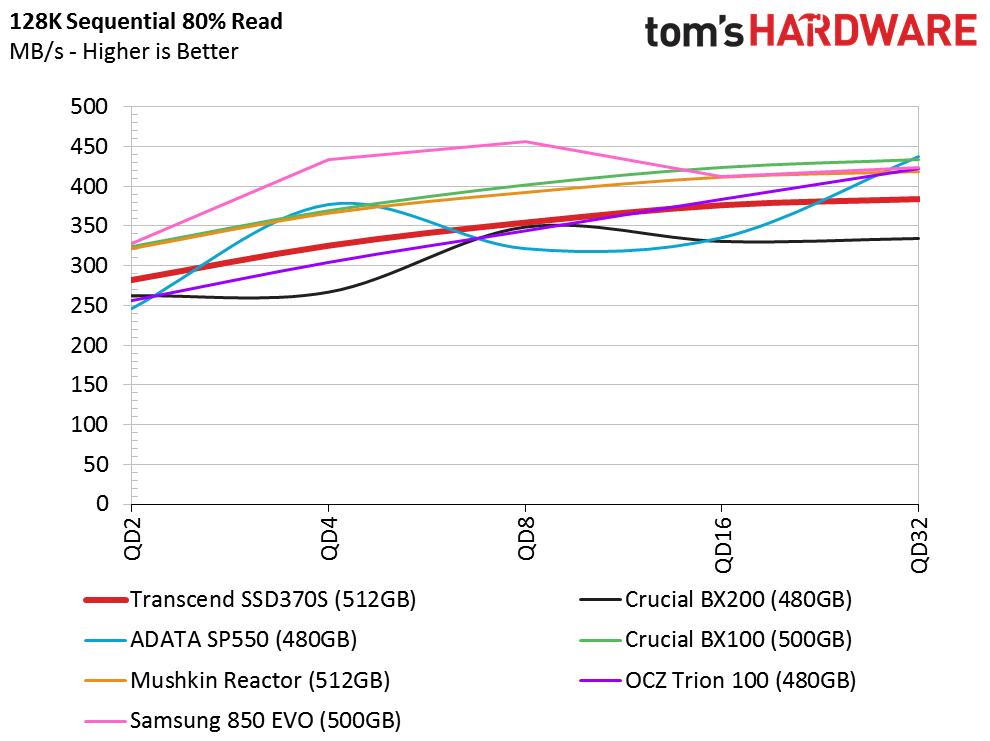Transcend SSD370S 512GB SSD Review
Transend's SSD370 we tested previously fell short of meeting our quality standards. But the SSD370S fixes those issues using Micron 16nm synchronous flash. Unfortunately, this model is also more expensive than its competition.
Why you can trust Tom's Hardware
Mixed Workload And Steady State
80 Percent Sequential Mixed Workload
Our mixed workload testing is described in detail here, and our steady state tests are described here.
Mixed workloads give us a better measuring stick for determining real-world client SSD performance. After all, it's rare to read or write exclusively on a drive with an operating system installed on it, since so much activity happens in the background that you never see.
In previous tests, the SSD370S and two other SM2246EN-based SSDs clumped together on the charts with very little separation. Now we do see some white space between them as Transcend's SSD370S trails the BX100 and Reactor.
80 Percent Random Mixed Workload
Our random mix also differentiates the SM2246EN-powered drives. This time, the Reactor and SSD370S trail Crucial's BX100. All of the SSDs trail the 850 EVO though (a common theme in every mid-range review these days).
Sequential Steady State



SATA is a half-duplex interface; it can't read and write at the same time. Some drives have problems queuing data, so when commands are stacked in a mixed workloads, performance is affected, resulting in the curve with high reads and writes like you see here. Most of the TLC-based drives give this test a new purpose. In it, we're able to identify native TLC write speed using 128KB blocks.
Again, the SSD370S trails both of the other SM2246EN-based drives. Interestingly, in the workstation (70 percent read) and desktop (80 percent read) workloads, some of the TLC drives actually perform a little better.
Random Write Steady State


We don't use the random 4KB steady state test to evaluate this enterprise-oriented workload condition. After all, these drives weren't meant for that application. Rather, we run it as a means of gauging performance consistency, and to identify the drives that may work well in desktop RAID. We've yet to find a value-class SSD that performs exceptionally well consistently once it's in steady state. The Transcend SSD370S is no exception.
Get Tom's Hardware's best news and in-depth reviews, straight to your inbox.
Current page: Mixed Workload And Steady State
Prev Page Four-Corner Testing Next Page Real-World Software Performance
Chris Ramseyer was a senior contributing editor for Tom's Hardware. He tested and reviewed consumer storage.
-
Co BIY If the Crucial BX100 is no longer available I don't think it belongs in the performance comparison charts. Although I see the value for analyzing the trends in the market it doesn't reflect the current state and gives Crucial undeserved positive exposure for a product they can no longer even bring to market.Reply
Seems that value SSDs are one area where we are not getting continuous performance improvement but instead some backslide. -
CRamseyer The BX100 is far from an obsolete product since anyone can still purchase the series at Newegg, Amazon and a number of other online stores. I would even go as far as to say some are still on retail shelves. It is also a product that many people know and can use to compare performance against.Reply
I do agree with your comment on mainstream performance moving the wrong direction. It's a trend we will have to live with until Toshiba, Micron and SK Hynix move to 3D like Samsung. Micron appears to be the first with some 3D flash expected in June or July. 2D TLC will survive and make up the entry-level sector. 3D TLC and 3D MLC will account for the mainstream and performance sectors of the market. -
Tony37x Your pricing on the Samsung 850 EVO 500GB is very misleading - It's actually less than both of these in the article @ $149 NOT $270!!! No brainer, go with the top-rated Samsung :)Reply
http://www.amazon.com/gp/product/B00OBRE5UE/?tag=bom_tomshardware-20 -
jai_123 Do you suggest using SSD370 on a RAID 1 ? I am planning to create a RAID 1, not yet finalized to choose a OS based RAID or use a cheap HW RAID adapter.Reply -
CRamseyer With RAID 1 you don't have to worry about the Yahtzee effect. In my next RAID Report I'll explain it with some additional detail.Reply
Most SSDs will work fine in RAID 1. -
shaolin95 So for someone with a SATA II only system trying to extend the life of anotherwise powerful system, is the 850 EVO the best option?Reply

